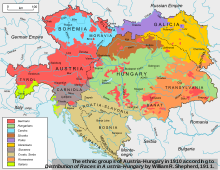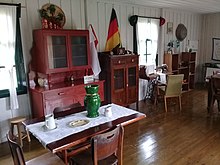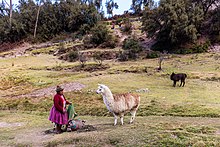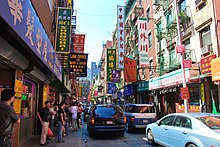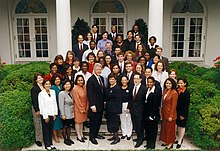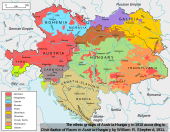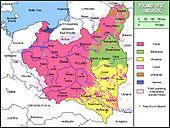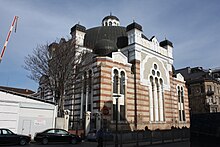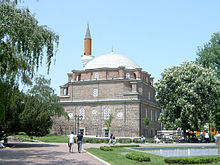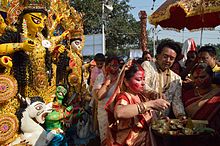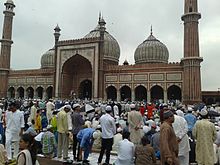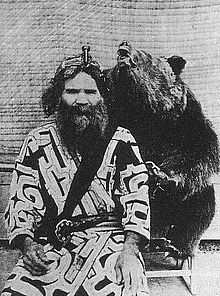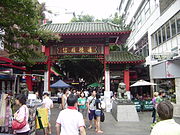From Wikipedia, the free encyclopedia
The term multiculturalism has a range of meanings within the contexts of sociology, of political philosophy, and of colloquial use. In sociology and in everyday usage, it is a synonym for "ethnic pluralism", with the two terms often used interchangeably, for example, a cultural pluralism
in which various ethnic groups collaborate and enter into a dialogue
with one another without having to sacrifice their particular
identities. It can describe a mixed ethnic community area where multiple
cultural traditions exist (such as New York City or Trieste) or a single country within which they do (such as Switzerland, Belgium or Russia). Groups associated with an indigenous, aboriginal or autochthonous ethnic group and settler-descended ethnic groups are often the focus.
In reference to sociology, multiculturalism is the end-state of
either a natural or artificial process (for example: legally-controlled immigration)
and occurs on either a large national scale or on a smaller scale
within a nation's communities. On a smaller scale this can occur
artificially when a jurisdiction is established or expanded by
amalgamating areas with two or more different cultures (e.g. French Canada and English Canada). On a large scale, it can occur as a result of either legal or illegal migration to and from different jurisdictions around the world.
In reference to political science, multiculturalism can be
defined as a state's capacity to effectively and efficiently deal with
cultural plurality within its sovereign borders. Multiculturalism as a
political philosophy involves ideologies and policies which vary widely. It has been described as a "salad bowl" and as a "cultural mosaic", in contrast to a "melting pot".
Prevalence
The concept of multiculturalism was prevalent since ancient times. The Achaemenid Empire founded by Cyrus the Great followed a policy of incorporating and tolerating various cultures.
Ethnographic map of Austria-Hungary
A historical example of multiculturalism was the Habsburg monarchy,
which had broken up in 1918 and under whose roof many different ethnic,
linguistic and religious groups lived together. One of the foundations
of this centuries-old state structure was the Habsburg principle of
"live and let live". Today's topical issues such as social and cultural
differentiation, multilingualism, competing identity offers or multiple
cultural identities have already shaped the scientific theories of many
thinkers of this multi-ethnic empire.
After the First World War, ethnic minorities were disadvantaged, forced
to emigrate or even murdered in most regions in the area of the former
Habsburg monarchy due to the prevailing nationalism at the time. In many
areas, these ethnic mosaics no longer exist today. The ethnic mix of
that time can only be experienced in a few areas, such as in the former
Habsburg port city of Trieste.
In the political philosophy
of multiculturalism, ideas are focused on the ways in which societies
are either believed to or should, respond to cultural and Christian
differences. It is often associated with "identity politics", "the
politics of difference", and "the politics of recognition". It is also a
matter of economic interests and political power.
In more recent times political multiculturalist ideologies have been
expanding in their use to include and define disadvantaged groups such
as African Americans, LGBT, with arguments often focusing on ethnic and religious minorities, minority nations, indigenous peoples
and even the disabled. It is within this context in which the term is
most commonly understood and the broadness and scope of the definition,
as well as its practical use, has been the subject of serious debate.
Most debates over multiculturalism center around whether or not
multiculturalism is the appropriate way to deal with diversity and
immigrant integration. The arguments regarding the perceived rights to a
multicultural education include the proposition that it acts as a way
to demand recognition of aspects of a group's culture subordination and
its entire experience in contrast to a melting pot or non-multicultural societies.
The term multiculturalism is most often used in reference to Western nation-states, which had seemingly achieved a de facto single national identity during the 18th and/or 19th centuries.
Multiculturalism has been official policy in several Western nations since the 1970s, for reasons that varied from country to country, including the fact that many of the great cities of the Western world are increasingly made of a mosaic of cultures.
The Canadian government has often been described as the instigator of multicultural ideology because of its public emphasis on the social importance of immigration. The Canadian Royal Commission on Bilingualism and Biculturalism is often referred to as the origins of modern political awareness of multiculturalism.
Canada has provided provisions to the French speaking majority of
Quebec, whereby they function as an autonomous community with special
rights to govern the members of their community, as well as establish
French as one of the official languages. In the Western English-speaking
countries, multiculturalism as an official national policy started in
Canada in 1971, followed by Australia in 1973 where it is maintained
today. It was quickly adopted as official policy by most member-states of the European Union. Recently, right-of-center governments in several European states – notably the Netherlands and Denmark – have reversed the national policy and returned to an official monoculturalism.
A similar reversal is the subject of debate in the United Kingdom,
among others, due to evidence of incipient segregation and anxieties
over "home-grown" terrorism.
Several heads-of-state or heads-of-government have expressed doubts
about the success of multicultural policies: The United Kingdom's ex-Prime Minister David Cameron, German Chancellor Angela Merkel, Australia's ex-prime minister John Howard, Spanish ex-prime minister Jose Maria Aznar and French ex-president Nicolas Sarkozy have voiced concerns about the effectiveness of their multicultural policies for integrating immigrants.
Many nation-states in Africa, Asia, and the Americas are culturally diverse and are 'multicultural' in a descriptive sense. In some, communalism
is a major political issue. The policies adopted by these states often
have parallels with multiculturalist policies in the Western world, but
the historical background is different, and the goal may be a
mono-cultural or mono-ethnic nation-building – for instance in the Malaysian government's attempt to create a 'Malaysian race' by 2020.
Support
Multiculturalism is seen by its supporters as a fairer system that
allows people to truly express who they are within a society, that is
more tolerant and that adapts better to social issues.
They argue that culture is not one definable thing based on one race or
religion, but rather the result of multiple factors that change as the
world changes.
Historically, support for modern multiculturalism stems from the
changes in Western societies after World War II, in what Susanne
Wessendorf calls the "human rights revolution", in which the horrors of
institutionalized racism and ethnic cleansing became almost impossible to ignore in the wake of the Holocaust; with the collapse of the European colonial system, as colonized nations in Africa and Asia successfully fought for their independence
and pointed out the discriminatory underpinnings of the colonial
system; and, in the United States in particular, with the rise of the Civil Rights Movement, which criticized ideals of assimilation
that often led to prejudices against those who did not act according to
Anglo-American standards and which led to the development of academic ethnic studies programs as a way to counteract the neglect of contributions by racial minorities in classrooms. As this history shows, multiculturalism in Western countries was seen
to combat racism, to protect minority communities of all types, and to
undo policies that had prevented minorities from having full access to
the opportunities for freedom and equality promised by the liberalism that has been the hallmark of Western societies since the Age of Enlightenment. The contact hypothesis
in sociology is a well-documented phenomenon in which cooperative
interactions with those from a different group than one's own reduce
prejudice and inter-group hostility.
Will Kymlicka argues for "group differentiated rights", that help
both religious and cultural minorities operate within the larger state
as a whole, without impinging on the rights of the larger society. He
bases this on his opinion that human rights fall short in protecting the
rights of minorities, as the state has no stake in protecting the
minorities.
C. James Trotman argues that multiculturalism is valuable because
it "uses several disciplines to highlight neglected aspects of our
social history, particularly the histories of women and minorities
[...and] promotes respect for the dignity of the lives and voices of the
forgotten. By closing gaps, by raising consciousness about the past, multiculturalism tries to restore a sense of wholeness in a postmodern era that fragments human life and thought."
Tariq Modood
argues that in the early years of the 21st century, multiculturalism
"is most timely and necessary, and [...] we need more not less", since
it is "the form of integration" that (1) best fits the ideal of egalitarianism, (2) has "the best chance of succeeding" in the "post-9/11, post 7/7" world, and (3) has remained "moderate [and] pragmatic".
Bhikhu Parekh
counters what he sees as the tendencies to equate multiculturalism with
racial minorities "demanding special rights" and to see these as
promoting a "thinly veiled racis[m]". Instead, he argues that
multiculturalism is in fact "not about minorities" but "is about the
proper terms of the relationship between different cultural
communities", which means that the standards by which the communities
resolve their differences, e.g., "the principles of justice" must not
come from only one of the cultures but must come "through an open and
equal dialogue between them."
Balibar characterizes criticisms of multiculturalism as
"differentialist racism", which he describes as a covert form of racism
that does not purport ethnic superiority as much as it asserts
stereotypes of perceived "incompatibility of life-styles and
traditions".
While there is research that suggests that ethnic diversity
increases chances of war, lower public goods provision and decreases
democratization, there is also research that shows that ethnic diversity
in itself is not detrimental to peace, public goods provision, or democracy. Rather, it was found that promoting diversity actually helps in advancing disadvantaged students. A 2018 study in the American Political Science Review cast doubts on findings that ethnoracial homogeneity led to greater public goods provision. A 2015 study in the American Journal of Sociology challenged past research showing that racial diversity adversely affected trust.
Criticism
Critics of multiculturalism often debate whether the multicultural
ideal of benignly co-existing cultures that interrelate and influence
one another, and yet remain distinct, is sustainable, paradoxical, or
even desirable. It is argued that nation states,
who would previously have been synonymous with a distinctive cultural
identity of their own, lose out to enforced multiculturalism and that
this ultimately erodes the host nations' distinct culture.
Sarah Song views cultures as historically shaped entities by its
members, and that they lack boundaries due to globalization, thereby
making them stronger than what others may assume.
She goes on to argue against the notion of special rights as she feels
cultures are mutually constructive, and are shaped by the dominant
culture. Brian Barry advocates a difference-blind approach to culture in
the political realm and he rejects group-based rights as antithetical
to the universalist liberal project, which he views as based on the
individual.
Harvard professor of political science Robert D. Putnam conducted a nearly decade-long study on how multiculturalism affects social trust.
He surveyed 26,200 people in 40 American communities, finding that when
the data were adjusted for class, income and other factors, the more
racially diverse a community is, the greater the loss of trust. People
in diverse communities "don’t trust the local mayor, they don’t trust
the local paper, they don’t trust other people and they don’t trust
institutions," writes Putnam.
In the presence of such ethnic diversity, Putnam maintains that, "[W]e
hunker down. We act like turtles. The effect of diversity is worse than
had been imagined. And it’s not just that we don’t trust people who are
not like us. In diverse communities, we don’t trust people who do not
look like us".
Putnam has also stated, however, that "this allergy to diversity tends
to diminish and to go away... I think in the long run we'll all be
better."
Putnam denied allegations he was arguing against diversity in society
and contended that his paper had been "twisted" to make a case against
race-conscious admissions to universities. He asserted that his
"extensive research and experience confirm the substantial benefits of
diversity, including racial and ethnic diversity, to our society."
Ethnologist Frank Salter writes:
Relatively homogeneous societies invest more in public goods,
indicating a higher level of public altruism. For example, the degree of
ethnic homogeneity correlates with the government's share of gross
domestic product as well as the average wealth of citizens. Case studies
of the United States, Africa and South-East Asia find that multi-ethnic
societies are less charitable and less able to cooperate to develop
public infrastructure. Moscow beggars receive more gifts from fellow
ethnics than from other ethnies [sic].
A recent multi-city study of municipal spending on public goods in the
United States found that ethnically or racially diverse cities spend a
smaller portion of their budgets and less per capita on public services
than do the more homogeneous cities.
Dick Lamm, former three-term Democratic governor of the US state of Colorado,
argued that "diverse peoples worldwide are mostly engaged in hating
each other—that is, when they are not killing each other. A diverse,
peaceful, or stable society is against most historical precedent."
The American classicist Victor Davis Hanson
used the perceived differences in "rationality" between Moctezuma and
Cortés to argue that Western culture was superior to every culture in
the entire world, which thus led him to reject multiculturalism as a
false doctrine that placed all cultures on an equal footing.
In New Zealand (Aotearoa), which is officially bi-cultural, multiculturalism has been seen as a threat to the Māori, and possibly an attempt by the New Zealand Government to undermine Māori demands for self-determination and encourage assimilation.
Far-right sympathisers have been shown to increasingly take part
in a multitude of online discursive efforts directed against global
brands’ multicultural advertisements.
The Americas
Argentina
Though not called Multiculturalism as such, the preamble of Argentina's constitution explicitly promotes immigration, and recognizes the individual's multiple citizenship from other countries. Though 97% of Argentina's population self-identify as of European descent to this day a high level of multiculturalism remains a feature of Argentina's culture, allowing foreign festivals and holidays (e.g. Saint Patrick's Day), supporting all kinds of art or cultural expression from ethnic groups,
as well as their diffusion through an important multicultural presence
in the media; for instance it is not uncommon to find newspapers or radio programs in English, German, Italian, French or Portuguese in Argentina.
Bolivia
Bolivia is a diverse country made up of 36 different types of indigenous groups. Over 62% of Bolivia's population falls into these different indigenous groups, making it the most indigenous country in Latin America. Out of the indigenous groups the Aymara and the Quechua are the largest. The latter 30% of the population is a part of the mestizo, which are a people mixed with European and indigenous ancestry.
Bolivia's political administrations have endorsed multicultural
politics and in 2009 Bolivia's Constitution was inscribed with
multicultural principles. The Constitution of Bolivia recognizes 36 official languages besides Spanish, each language has its own culture and indigenous group.
Bolivian culture is celebrated across the country and has heavy
influences from the Aymara, the Quechua, the Spanish, and other popular
cultures from around Latin America.
Brazil
The Americas have been known to be some of the most multicultural
geographical locations, with a diversity of language, religion, and
ethnicity. The South American country Brazil
can also acclaim multiculturalism, and has undergone many changes in
the past few decades. Brazil is a controversial country when it comes to
defining a multicultural country.
There are two views: the Harvard Institute of Economic Research states
that Brazil has an intersection of many cultures because of recent
migration, while the Pew Research Center state that Brazil is culturally diverse but the majority of the country speaks Portuguese.
Cities such as São Paulo are home to migrants from Japan, Italy, Lebanon and Portugal.
There is a multicultural presence within in this city, and this is
prevalent throughout Brazil. Furthermore, Brazil is a country that has
made great strides to embrace migrant cultures. There has been increased
awareness of anti-blackness and active efforts to combat racism.
Canada
Canadian society is often depicted as being "very progressive, diverse, and multicultural". Multiculturalism (a Just Society) was adopted as the official policy of the Canadian government during the premiership of Pierre Elliott Trudeau in the 1970s and 1980s. Multiculturalism is reflected in the law through the Canadian Multiculturalism Act and section 27 of the Canadian Charter of Rights and Freedoms. The Broadcasting Act of 1991 asserts the Canadian broadcasting system should reflect the diversity of cultures in the country.
Canadian multiculturalism is looked upon with admiration outside the
country, resulting in the Canadian public dismissing most critics of the
concept. Multiculturalism in Canada is often looked at as one of Canada's significant accomplishments, and a key distinguishing element of Canadian identity.
In a 2002 interview with The Globe and Mail, Karīm al-Hussainī, the 49th Aga Khan of the Ismaili Muslims, described Canada as "the most successful pluralist society on the face of our globe", citing it as "a model for the world".
He explained that the experience of Canadian governance—its commitment
to pluralism and its support for the rich multicultural diversity of its
people—is something that must be shared and would be of benefit to all
societies in other parts of the world. The Economist ran a cover story in 2016 praising Canada as the most successful multicultural society in the West. The Economist
argued that Canada's multiculturalism was a source of strength that
united the diverse population and by attracting immigrants from around
the world was also an engine of economic growth as well. Many public and private groups in Canada work to support both multiculturalism and recent immigrants to Canada.
In an effort to support recent Filipino immigrants to Alberta, for
example, one school board partnered with a local university and an
immigration agency to support these new families in their school and
community.
Mexico
Mexico has historically always been a multicultural country. After the betrayal of Hernán Cortés to the Aztecs, the Spanish conquered the Aztec Empire and colonized indigenous people. They influenced the indigenous religion, politics, culture and ethnicity. The Spanish opened schools in which they taught Christianity, and the Spanish language
eventually surpassed indigenous languages, making it the most spoken
language in Mexico. Mestizo was also born from the conquest, which meant
being half-Indigenous and half-Spanish.
Mexico City
has recently been integrating rapidly, doing much better than many
cities in a sample conducted by the Intercultural Cities Index (being
the only non-European city, alongside Montreal, on the index). Mexico is an ethnically diverse country with a population composed of approximately 123 million in 2017. There is a wide variety of ethnic groups, the major group being Mestizos followed by Indigenous Mexicans. There are many other ethnic groups such as Arab Mexicans, Afro-Mexicans, Asian Mexicans and White Mexicans.
From the year 2000 to 2010, the number of people in Mexico that
were born in another country doubled, reaching a total of 961,121
people, mostly coming from Guatemala and the United States. Mexico is quickly becoming a melting pot, with many immigrants coming into the country. It is considered to be a cradle of civilization,
which influences their multiculturalism and diversity, by having
different civilizations influence them. A distinguishable trait of
Mexico's culture is the mestizaje
of its people, which caused the combination of Spanish influence, their
indigenous roots while also adapting the culture traditions from their
immigrants.
Peru
Peru is an exemplary country of multiculturalism, in 2016 the INEI
reported a total population of 31 million people. They share their
borders with Ecuador, Colombia, Brazil, Chile and Bolivia, and have
welcomed many immigrants into their country creating a diverse
community.
Peru is the home to Amerindians but after the Spanish Conquest,
the Spanish brought African, and Asian peoples as slaves to Peru
creating a mix of ethnic groups. After slavery was no longer permitted
in Peru, African-Peruvians and Asian-Peruvians have contributed to
Peruvian culture in many ways. Today, Amerindians make up 45% of the
population, Mestizos 37%, white 15% and 3% is composed by black, Chinese, and others.
In 1821, Peru's president José de San Martín gave foreigners the
freedom to start industries in Peru's ground, 2 years after, foreigners
that lived in Peru for more than 5 years were considered naturalized
citizens, which then decreased to 3 years.
United States
In the United States, multiculturalism is not clearly established in
policy at the federal level, but ethnic diversity is common in rural, suburban and urban areas.
Continuous mass immigration was a feature of the United States economy and society since the first half of the 19th century. The absorption of the stream of immigrants became, in itself, a prominent feature of America's national myth. The idea of the melting pot is a metaphor that implies that all the immigrant cultures are mixed and amalgamated without state intervention.
The melting pot theory implied that each individual immigrant, and each
group of immigrants, assimilated into American society at their own
pace. This is different than multiculturalism as it is defined above,
which does not include complete assimilation and integration. The melting pot tradition co-exists with a belief in national unity, dating from the American founding fathers:
Providence has been pleased to give this one connected
country to one united people – a people descended from the same
ancestors, speaking the same language, professing the same religion,
attached to the same principles of government, very similar in their
manners and customs... This country and this people seem to have been
made for each other, and it appears as if it was the design of
Providence, that an inheritance so proper and convenient for a band of
brethren, united to each other by the strongest ties, should never be
split into a number of unsocial, jealous, and alien sovereignties.
Staff of President Clinton's
One America Initiative.
The President's Initiative on Race was a critical element in President
Clinton's effort to prepare the country to embrace diversity.
As a philosophy, multiculturalism began as part of the pragmatism movement at the end of the 19th century in Europe and the United States, then as political and cultural pluralism at the turn of the 20th.
It was partly in response to a new wave of European imperialism in
sub-Saharan Africa and the massive immigration of Southern and Eastern
Europeans to the United States and Latin America. Philosophers, psychologists and historians and early sociologists such as Charles Sanders Peirce, William James, George Santayana, Horace Kallen, John Dewey, W. E. B. Du Bois and Alain Locke developed concepts of cultural pluralism, from which emerged what we understand today as multiculturalism. In Pluralistic Universe (1909), William James espoused the idea of a "plural society." James saw pluralism as "crucial to the formation of philosophical and social humanism to help build a better, more egalitarian society.
The educational approach to multiculturalism has since spread to the grade school
system, as school systems try to rework their curricula to introduce
students to diversity earlier – often on the grounds that it is
important for minority students to see themselves represented in the
classroom. Studies estimated 46 million Americans ages 14 to 24 to be the most diverse generation in American society.
In 2009 and 2010, controversy erupted in Texas as the state's
curriculum committee made several changes to the state's requirements,
often at the expense of minorities. They chose to juxtapose Abraham Lincoln's inaugural address with that of Confederate president Jefferson Davis; they debated removing Supreme Court Justice Thurgood Marshall and labor-leader Cesar Chavez and rejected calls to include more Hispanic figures, in spite of the high Hispanic population in the state.
Effect of diversity on civic engagement
In a 2007 study by Robert Putnam
encompassing 30,000 people across the US found that diversity had a
negative effect on civic engagement. The greater the diversity, the
fewer people voted, the less they volunteered for community projects and
trust among neighbours was only half that of homogenous communities.
Putnam says, however, that "in the long run immigration and diversity
are likely to have important cultural, economic, fiscal, and
developmental benefits", as long as society successfully overcomes the
short-term problems.
Putnam adds that his "extensive research and experience confirm the
substantial benefits of diversity, including racial and ethnic
diversity, to our society."
Venezuela
Venezuela is the home to a variety of ethnic groups, with an estimated population of 32 million. Their population is composed of approximately 68% Mestizo, which means of mixed race. Venezuelan culture is mainly composed by the mixture of their indigenous people, Spanish and African.
There was a heavy influence of Spaniard culture due to the Spanish
Conquest, which influence their religion, language, traditions. African
influence can be seen on their music, with the drum usage. While Spanish is Venezuela's main language, there is more than 40 indigenous languages spoken til this day.
Europe
The European Union
is facing unprecedented demographic changes (an aging population, low
birth rates, changing family structures and migration). According to the
European Commission, it is important, both at EU and national level, to
review and adapt existing policies. Following a public debate, a 2006
EU policy paper identified five key policy responses to manage
demographic change, among them receiving and integrating migrants into
Europe.
Historically, Europe has always been a mixture of Latin, Slavic,
Germanic, Uralic, Celtic, Hellenic, Illyrian, Thracian and other
cultures influenced by the importation of Jewish, Christian, Muslim and
other belief systems; although the continent was supposedly unified by
the super-position of Imperial Roman Christianity, it is accepted that
geographic and cultural differences continued from antiquity into the
modern age.
In the nineteenth century, the ideology of nationalism transformed the way Europeans thought about the state. Existing states were broken up and new ones created; the new nation-states were founded on the principle that each nation is entitled to its own sovereignty
and to engender, protect, and preserve its own unique culture and
history. Unity, under this ideology, is seen as an essential feature of
the nation and the nation-state; unity of descent, unity of culture,
unity of language, and often unity of religion. The nation-state
constitutes a culturally homogeneous society, although some national movements recognised regional differences.
Where cultural unity was insufficient, it was encouraged and enforced by the state. The nineteenth century nation-states developed an array of policies – the most important was compulsory primary education in the national language.
The language itself was often standardised by a linguistic academy, and
regional languages were ignored or suppressed. Some nation-states
pursued violent policies of cultural assimilation and even ethnic cleansing.
Some countries in the European Union have introduced policies for
"social cohesion", "integration", and (sometimes) "assimilation". The
policies include:
Other countries have instituted policies which encourage cultural separation. The concept of "Cultural exception" proposed by France
in the General Agreement on Tariffs and Trade (GATT) negotiations in
1993 was an example of a measure aimed at protecting local cultures.
Bulgaria
Since its establishment in the seventh century, Bulgaria has hosted many religions, ethnic groups and nations. The capital city Sofia is the only European city that has peacefully functioning, within walking distance of 300 metres, four Places of worship of the major religions: Eastern Orthodox (St Nedelya Church), Islam (Banya Bashi Mosque), Roman Catholicism (St. Joseph Cathedral), and Orthodox Judaism (Sofia Synagogue, the third-largest synagogue in Europe).
This unique arrangement has been called by historians a "multicultural cliche". It has also become known as "The Square of Religious Tolerance" and has initiated the construction of a 100-square-metre scale model of the site that is to become a symbol of the capital.
Furthermore, unlike some other Nazi Germany allies or German-occupied countries excluding Denmark, Bulgaria managed to save its entire 48,000-strong Jewish population during World War II from deportation to Nazi concentration camps.
According to Dr Marinova-Christidi, the main reason for the efforts of
Bulgarian people to save their Jewish population during WWII is that
within the region, they "co-existed for centuries with other religions" –
giving it a unique multicultural and multiethnic history.
Consequently, within the Balkan region, Bulgaria has become an
example for multiculturalism in terms of variety of religions, artistic
creativity and ethnicity.
Its largest ethnic minority groups, Turks and Roma, enjoy wide
political representation. In 1984, following a campaign by the Communist
regime for a forcible change of the Islamic names of the Turkish
minority,
an underground organisation called «National Liberation Movement of the
Turks in Bulgaria» was formed which headed the Turkish community's
opposition movement. On 4 January 1990, the activists of the movement
registered an organisation with the legal name Movement for Rights and Freedoms
(MRF) (in Bulgarian: Движение за права и свободи: in Turkish: Hak ve
Özgürlükler Hareketi) in the Bulgarian city of Varna. At the moment of
registration, it had 33 members, at present, according to the
organisation's website, 68,000 members plus 24,000 in the organisation's
youth wing.
In 2012, Bulgarian Turks were represented at every level of government:
local, with MRF having mayors in 35 municipalities, at parliamentary
level with MRF having 38 deputies (14% of the votes in Parliamentary
elections for 2009–13) and at executive level, where there is one Turkish minister, Vezhdi Rashidov. 21 Roma political organisations were founded between 1997-2003 in Bulgaria.
Germany
In October 2010, Angela Merkel told a meeting of younger members of her Christian Democratic Union (CDU) party at Potsdam, near Berlin, that attempts to build a multicultural society in Germany had "utterly failed", stating: "The concept that we are now living side by side and are happy about it does not work".
She continued to say that immigrants should integrate and adopt
Germany's culture and values. This has added to a growing debate within
Germany
on the levels of immigration, its effect on Germany and the degree to
which Muslim immigrants have integrated into German society. In 2015, Merkel again criticized multiculturalism on the grounds that it leads to parallel societies.
The Ahmadiyya
Muslim Community of Germany is the first Muslim group to have been
granted "corporation under public law status", putting the community on
par with the major Christian churches and Jewish communities of Germany.
Luxembourg
Luxembourg
has one of the highest foreign-born populations in Europe, foreigners
account for nearly half of the country's total population. The majority of foreigners are from: Belgium, France, Italy, Germany, and Portugal. In total, 170 different nationalities make up the population of Luxembourg, out of this; 86% are of European descent. The official languages of Luxembourg are German, French, and Luxembourgish all of which are supported in the Luxembourg government and education system. In 2005, Luxembourg officially promoted and implemented the objectives of the UNESCO
Convention on the Protection and Promotion of the Diversity of Cultural
Expressions. This Convention affirms multicultural policies in
Luxembourg and creates political awareness of cultural diversity.
Netherlands
Süleymanìye Mosque in
Tilburg built in 2001
Multiculturalism in the Netherlands began with major increases in immigration to the Netherlands during the mid-1950s and 1960s. As a consequence, an official national policy of multiculturalism was adopted in the early-1980s.
Different groups could themselves determine religious and cultural
matters, while state authorities would handle matters of housing and
work policy.
In the 1990s, the public debate were generally optimistic on
immigration and the prevailing view was that a multicultural policy
would reduce the social economic disparities over time.
This policy subsequently gave way to more assimilationist
policies in the 1990s and post-electoral surveys uniformly showed from
1994 onwards that a majority preferred that immigrants assimilated
rather than retained the culture of their country of origin.
Following the September 11 attacks in the United States and the murders of Pim Fortuyn (in 2002) and Theo van Gogh (in 2004) there was increased political debate on the role of multiculturalism in the Netherlands.
Lord Sacks,
Chief Rabbi of the United Hebrew Congregations of the Commonwealth,
made a distinction between tolerance and multiculturalism, citing the
Netherlands as a tolerant, rather than multicultural, society. In June 2011, the First Rutte cabinet said the Netherlands would turn away from multiculturalism: "Dutch culture, norms and values must be dominant" Minister Donner said.
Romania
Since
Antiquity, Romania has hosted many religious and ethnic groups,
including Roma people, Hungarians, Germans, Turks, Greeks, Tatars,
Slovaks, Serbs, Jews and others. Unfortunately, during the WW2 and the
Communism, most of these ethnic groups choose to emigrate to other
countries. However, since 1990s, Romania has expected a growing number
of immigrants and refugees, most of them from the Arab World, Asia or
Africa. Immigration is expected to increase in the future, as large
numbers of Romanian workers leave the country and are being replaced by
foreigners.
Scandinavia
Multiculturalism in Scandinavia has centered on discussions about
marriage, dress, religious schools, Muslim funeral rites and gender
equality. Forced marriages have been widely debated in Denmark, Sweden and Norway but the countries differ in policy and responses by authorities.
Despite differing approaches by the three countries with Sweden being the most permissive and Denmark the most restrictive.
Denmark
In 2001, Denmark received a liberal-conservative government which was supported by the Danish People's Party which instituted a policy less pluralistic and more geared towards assimilation.
A 2018 study found that increases in local ethnic diversity in
Denmark caused "rightward shifts in election outcomes by shifting
electoral support away from traditional “big government” left‐wing
parties and towards anti‐immigrant nationalist parties."
For decades, Danish immigration and integration policy was built
upon the assumption that with the right kind of help, immigrants and
their descendants will eventually tend to the same levels of education
and employments as Danes. This assumption was disproved by a 2019 report by the Danish Immigration Service and the Ministry of Education.
The report found that while the second generation non-Western
immigrants do better than the first generation, the third generation of
immigrants with non-Western background do no better education and
employment wise than the second generation. One of the reasons was that
second generation immigrants from non-Western countries marry someone
from their country of origin and so Danish is not spoken at home which
disadvantages children in school. Thereby the process of integration has
to start from the beginning for each generation.
Sweden
Sweden has from the early 1970s experienced a greater share of
non-Western immigration than the other Scandinavian countries, which
consequently have placed multiculturalism on the political agenda for a
longer period of time.
Sweden was the first country to adopt an official policy of
multiculturalism in Europe. On 14 May 1975, a unanimous Swedish
parliament passed an act on a new multiculturalist immigrant and ethnic
minority policy put forward by the social democratic government, that explicitly rejected the ideal ethnic homogeneity and the policy of assimilation.
The three main principles of the new policy were equality, partnership
and freedom of choice. The explicit policy aim of the freedom of choice
principle was to create the opportunity for minority groups in Sweden to
retain their own languages and cultures. From the mid-1970s, the goal
of enabling the preservation of minorities and creating a positive
attitude towards the new officially endorsed multicultural society among
the majority population became incorporated into the Swedish
constitution as well as cultural, educational and media policies.
Despite the anti-multiculturalist protestations of the Sweden Democrats, multiculturalism remains official policy in Sweden.
A 2008 study which involved questionnaires sent to 5,000 people,
showed that less than a quarter of the respondents (23%) wanted to live
in areas characterised by cultural, ethnic and social diversity.
A 2014 study published by Gävle University College showed that 38% of the population never interacted with anyone from Africa and 20% never interacted with any non-Europeans.
The study concluded that while physical distance to the country of
origin, also religion and other cultural expressions are significant for
the perception of cultural familiarity. In general, peoples with Christianity as the dominant religion were perceived to be culturally closer than peoples from Muslim countries.
A 2017 study by Lund University
also found that social trust was lower among people in regions with
high levels of past non-Nordic immigration than among people in regions
with low levels of past immigration. The erosive effect on trust was more pronounced for immigration from culturally distant countries.
Serbia
In Serbia, there are 19 officially recognised ethnic groups with a status of national minorities. Vojvodina is an autonomous province of Serbia, located in the northern part of the country. It has a multiethnic and multicultural identity; there are more than 26 ethnic groups in the province, which has six official languages. Largest ethnic groups in Vojvodina are Serbs (67%), Hungarians (13%), Slovaks, Croats, Romani, Romanians, Montenegrins, Bunjevci, Bosniaks, Rusyns. The Chinese and Arabs, are the only two significant immigrant minorities in Serbia.
Radio Television of Vojvodina broadcasts program in ten local languages. The project by the Government of AP Vojvodina
titled "Promotion of Multiculturalism and Tolerance in Vojvodina",
whose primary goal is to foster the cultural diversity and develop the
atmosphere of interethnic tolerance among the citizens of Vojvodina, has
been successfully implemented since 2005.
Serbia is continually working on improving its relationship and
inclusion of minorities in its effort to gain full accession to the
European Union. Serbia has initiated talks through Stabilisation and
Association Agreement on 7 November 2007.
United Kingdom
Multicultural policies were adopted by local administrations from the 1970s and 1980s onwards. In 1997, the newly elected Labour government committed to a multiculturalist approach at a national level, but after 2001, there was something of a backlash, led by centre-left commentators such as David Goodhart and Trevor Phillips. The Government then embraced a policy of community cohesion instead. In 2011, Conservative Prime Minister David Cameron said in a speech that "state multiculturalism has failed".
Critics argue that analyses which view society as ‘too diverse’ for
social democracy and cohesion have "performative" effects that
legitimate racism towards those classed as immigrants.
Asia
India
According to the 1961 Census of India, there are 1652 indigenous languages in the country. The culture of India has been shaped by its long history, unique geography and diverse demography. India's languages, religions, dance,
music, architecture and customs differ from place to place within the
country, but nevertheless possess a commonality. The culture of India is
an amalgamation of these diverse sub-cultures spread all over the Indian subcontinent and traditions that are several millennia old. The previously prevalent Indian caste system
describes the social stratification and social restrictions in the
Indian subcontinent, in which social classes are defined by thousands of
endogamous hereditary groups, often termed jātis or castes.
Religiously, Hindus form the majority, followed by Muslims. The statistics are: Hindu (79.8%), Muslim (14.2%), Christian (2.3%), Sikh (1.7%), Buddhist (0.7%), Jain (0.4%), Unaffiliated (0.23%), Baháʼís, Jews, Zoroastrians, and others (0.65%). Linguistically, the two main language families in India are Indo-Aryan (a branch of Indo-European) and Dravidian. In India's northeast, people speaking Sino-Tibetan group of languages such as Meitei (Meitei-lon) recognized by the Indian constitution and Austroasiatic languages are commonly found. India (officially) follows a three-language policy. Hindi (spoken in the form of Hindustani) is the official federal language, English
has the federal status of associate/subsidiary official language and
each state has its own state official language (in the Hindi sprachraum, this reduces to bilingualism). Further, India does not have any national language. The Republic of India's
state boundaries are largely drawn based on linguistic groups; this
decision led to the preservation and continuation of local
ethno-linguistic sub-cultures, except for the Hindi sprachraum which is itself divided into many states. Thus, most states differ from one another in language, culture, cuisine, clothing, literary style, architecture, music and festivities.
India has encountered religiously motivated violence, such as the Moplah Riots, the Bombay riots, the 1984 anti-Sikh riots, the 1990 Kashmiri Pandit genocide, the 2002 Gujarat riots, the 2008 Mumbai attacks, the 2012 Assam violence, the 2013 Muzaffarnagar riots, and the 2020 Delhi riots.
This has resulted from traditionally disadvantaged communities in
public employment such as the policing of the same locality,
apprehension of owners in giving properties for sale or rent and of society in accepting inter-marriages.
Cultural minorities in India
The
Indian constitution requires the various state-run institutions to
provide quotas for minorities, which give these cultural minorities
equal opportunities, as well as a forum through which they can actively
participate in the institutions of the dominant culture.
Indian polity after the 1990s has been marked by a shift from secular
principles to a landscape that is dominated by pro-Hindu propaganda; the
BJP has used this rhetoric by reconstructing Hinduism and bartering it
under the guise of Indian nationalism. However, the rise of pro-Hindu ideology, commonly known as Hindutva, has impinged on the rights of cultural minorities.
This can be seen in the large scale violence against cultural
minorities, the vote-bank politics used by the Indian National Congress,
and the promotion of issues faced by the larger religious communities
over those faced by the backward groups in religious minorities.
Scheduled Castes (SC) and Scheduled Tribes (ST)
Scheduled
Castes and Scheduled Tribes are constitutionally recognized terms in
India and constitute approximately 25% of the Indian population. These
groups have been provided with reservations that constitutionally
guarantee them representation in governmental institutions, a mandate
suggested by the Mandal Commission.
The Indian constitution also provides SC's and ST's with protective
measures that ensure equality, which is the main issue faced by members
of both communities. However, while scheduled castes have turned into
important political communities that the state concerns itself about,
scheduled tribes continue to be politically marginalized.
Indonesia
Pluralism, diversity and multiculturalism is a daily fact of life in Indonesia. There are over 1,300 ethnic groups in Indonesia. 95% of those are of Native Indonesian ancestry. The Javanese are the largest ethnic group in Indonesia who make up nearly 42% of the total population. The Sundanese, Malay, and Madurese are the next largest groups in the country. There are also more than 700 living languages spoken in Indonesia and although predominantly Muslim the country also has large Christian and Hindu populations.
Indonesia's national motto, Bhinneka Tunggal Ika ("Unity in Diversity" lit. "many, yet one") enshrined in Pancasila the national ideology, articulates the diversity that shapes the country. The government nurtures and promotes the diversity of Indonesian local culture; adopting a pluralist approach.
Due to migration within Indonesia (as part of government transmigration programs
or otherwise), there are significant populations of ethnic groups who
reside outside of their traditional regions. The Javanese for example,
moved from their traditional homeland in Java to the other parts of the
archipelago. The expansion of the Javanese and their influence
throughout Indonesia has raised the issue of Javanization, although Minangkabau, Malay, Madurese, Bugis and Makassar people, as a result of their merantau (migrating) culture are also quite widely distributed throughout the Indonesian archipelago, while Chinese Indonesians can be found in most urban areas. Because of urbanization, major Indonesian cities such as Greater Jakarta, Surabaya, Bandung, Palembang, Medan and Makassar
have attracted large numbers of Indonesians from various ethnic,
cultural and religious backgrounds. Jakarta in particular has almost all
Indonesian ethnic groups represented.
However, this transmigration program and close interactions
between people of different cultural backgrounds caused socio-cultural
problems, as the inter-ethnics interactions have not always been
conducted harmoniously. After the fall of Suharto
in 1998 into the 2000s, numbers of inter-ethnic and inter-religious
clashes erupted in Indonesia. Like the clashes between native Dayak tribes against Madurese transmigrants in Kalimantan during Sambas riots in 1999 and the Sampit conflict in 2001. There were also clashes between Muslims and Christians, such as violence erupted in Poso between 1998 and into 2000, and violences in Maluku between 1999 and into 2002.
Nevertheless, Indonesia today still struggles and has managed to
maintain unity and inter-cultural harmony, through a national adherence
of pro-pluralism policy of Pancasila; promoted and enforced by the
government and its people.
Chinese Indonesians
are the largest foreign-origin minority that has resided in Indonesia
for generations. Despite centuries of acculturation with native
Indonesians, because of their disproportionate influence on Indonesian
economy, and alleged question of national loyalty, Chinese Indonesians
have suffered discrimination. The Suharto Orde Baru or New Order adopted a forced assimilation policy; which indicated that Chinese cultural elements were unacceptable. Chinese Indonesians were forced to adopt Indonesian-sounding names, and the use of Chinese culture and language was banned. The violence targeting Chinese Indonesians erupted during riots in 1998.
As the looting and destruction took place, a number of Chinese
Indonesians, as well as looters, were killed. The Chinese Indonesians
were treated as the scapegoat of 1997 Asian Financial Crisis,
a result of ongoing discrimination and segregation policies enforced
during Suharto's New Order regime. Soon after the fourth Indonesian
President, Abdurrahman Wahid
came into power in 1999, he quickly abolished some of the
discriminatory laws in efforts to promote acceptance and to improve
inter-racial relationships, such as abolishing the ban on Chinese
culture; allowing Chinese traditions to be practised freely. Two years
later President Megawati Sukarnoputri declared that the Chinese New Year (Imlek) would be marked as a national holiday from 2003. Today, Chinese Indonesians enjoy the same rights as other Indonesians.
Japan
Japanese society, with its ideology of homogeneity, has traditionally
rejected any need to recognize ethnic differences in Japan, even as
such claims have been rejected by such ethnic minorities as the Ainu and Ryukyuan people. In 2005, former Japanese Prime Minister and current Japanese Deputy Prime Minister Taro Aso described Japan as a "one civilization, one language, one culture and one race" nation. However, there are "International Society" NPOs funded by local governments throughout Japan.
According to Harvard University professor Theodore Bestor,
Japan does look very homogeneous from a distant perspective, but in
fact there are a number of very significant minority groups – ethnically
different minority groups – in Japan today, such as the already
mentioned Ainu and Ryukyuan people.
Kazakhstan
Kazakhstan
is among the most multicultural countries in Eurasia, with sizeable
populations of ethnic Kazakhs, Russians, Uzbeks, Ukrainians, Uighurs,
Tatars, Germans and more.
Kazakhstan is one of a few countries in post-Soviet territories that
managed to avoid interethnic clashes and conflicts in the period of
USSR’s final crisis and its eventual breakup. In 1995, Kazakhstan created the Assembly of People of Kazakhstan, an advisory body designed to represent the country's ethnic minorities.
Malaysia
Malaysia is a multiethnic country, with Malays making up the majority, close to 58% of the population. About 25% of the population are Malaysians of Chinese descent. Malaysians of Indian descent comprise about 7% of the population. The remaining 10% comprises:
- Native East Malaysians, namely Bajau, Bruneian, Bidayuh, Dusun, Iban, Kadazan, Kedayan, Melanau, Orang Ulu, Sarawakian Malays, etc.
- Other native tribes of Peninsular Malaysia, such as the Orang Asli and Siamese people, and
- Non-native tribes of Peninsular Malaysia such as the Chettiars, the Peranakan and the Portuguese.
The Malaysian New Economic Policy or NEP serves as a form of racial equalization.
It promotes structural changes in various aspects of life from
education to economic to social integration. Established after the 13 May racial riots of 1969, it sought to address the significant imbalance in the economic sphere where the minority Chinese population had substantial control over commercial activity in the country.
The Malay Peninsula has a long history of international trade contacts, influencing its ethnic and religious composition. Predominantly Malays
before the 18th century, the ethnic composition changed dramatically
when the British introduced new industries, and imported Chinese and
Indian labor. Several regions in the then British Malaya such as Penang, Malacca and Singapore
became Chinese dominated. Until the riots 1969, co-existence between
the three ethnicities (and other minor groups) was largely peaceful,
although the three main racial groups for the most part lived in
separate communities – the Malays in the villages, the Chinese in the
urban areas, and the Indians in the towns and plantation. More Malays
however have moved into the cities since the 1970s, and the proportion
of the non-Malays have been decreasing continually, especially the
Chinese, due in large part to lower birth-rate and emigration as a
result of institutionalized discrimination.
Preceding independence of the Federation of Malaya, a social contract was negotiated as the basis of a new society. The contract as reflected in the 1957 Malayan Constitution and the 1963 Malaysian Constitution
states that the immigrant groups are granted citizenship, and Malays'
special rights are guaranteed. This is often referred to the Bumiputra policy.
These pluralist
policies have come under pressure from racialist Malay parties, who
oppose perceived subversion of Malay rights. The issue is sometimes
related to the controversial status of religious freedom in Malaysia.
Singapore
Due to historical immigratipn trends, Singapore has a Chinese majority population with significant minority populations of Malays and Indians (predominantly Tamils). Other prominent smaller groups include Peranakans, Eurasians and Europeans. Besides English, Singapore recognizes three other languages—Malay, Mandarin Chinese and Tamil.
English was established as the medium of instruction in schools during
the 1960s and 1970s and is the language of trade and government while
the other three languages are taught as second languages ("mother
tongues"). Besides being a multilingual country, Singapore also acknowledges festivals celebrated by the three main ethnic communities.
Under the Raffles Plan of Singapore, the city was divided into ethnic enclaves such as Geylang, Chinatown, and Little India.
Housing in Singapore is governed by the Ethnic Integration Policy,
which ensures an even ethnic distribution throughout Singapore. A similar policy exists in politics as all Group Representation Constituencies are required to field at least one candidate from an ethnic minority.
South Korea
South Korea remains a relatively homogenous country ethnically, linguistically, and culturally. Foreigners, expatriates, and immigrants are often rejected by the mainstream South Korean society and face discrimination.
Han Geon-Soo 2007 notes the increased use of the word
"multiculturalism" in South Korea: "As the increase of foreign migrants
in [South] Korea transforms a single-ethnic homogeneous [South] Korean
society into multiethnic and multicultural one, [the South] Korean
government and the civil society pay close attention to multiculturalism
as an alternative value to their policy and social movement." He
argued, however, that "the current discourses and concerns on
multiculturalism in [South] Korea" lacked "the constructive and
analytical concepts for transforming a society".
The same year, Stephen Castles of the International Migration Institute argued:
- "Korea no longer has to decide whether it wants to become a
multicultural society. It made that decision years ago – perhaps
unconsciously – when it decided to be a full participant in the emerging
global economy. It confirmed that decision when it decided to actively
recruit foreign migrants to meet the economic and demographic needs of a
fast-growing society. Korea is faced by a different decision today:
what type of multicultural society does it want to be?"
The Korea Times suggested in 2009 that South Korea was likely to become a multicultural society. In 2010, an opinion editorial written by Peter Underwood for the JoongAng Ilbo
stated: "Media in [South] Korea is abuzz with the new era of
multiculturalism. With more than one million foreigners in [South]
Korea, 2 percent of the population comes from other cultures." He
further opined:
- "If you stay too long, Koreans become uncomfortable with you.
[...] Having a two percent foreign population unquestionably causes
ripples, but having one million temporary foreign residents does not
make Korea a multicultural society. [...] In many ways, this homogeneity
is one of Korea’s greatest strengths. Shared values create harmony.
Sacrifice for the nation is a given. Difficult and painful political and
economic initiatives are endured without discussion or debate. It is
easy to anticipate the needs and behavior of others. It is the
cornerstone that has helped Korea survive adversity. But there is a
downside, too. [...] Koreans are immersed in their culture and are thus
blind to its characteristics and quirks. Examples of group think are
everywhere. Because Koreans share values and views, they support
decisions even when they are obviously bad. Multiculturalism will
introduce contrasting views and challenge existing assumptions. While it
will undermine the homogeneity, it will enrich Koreans with a better
understanding of themselves."
In 2010, results from the Korean Identity Survey suggested that
government programs promoting multicultralism had seen some success with
over 60% of Koreans supporting the idea a multicultural society.
However, the same poll in 2015 showed that support of a multicultural
society had dropped to 49.7% suggesting a possible return to ethnic
exclusivism.
Turkey
Turkey
is a country that borders both Europe and Asia, therefore placing it as
the multicultural intersection for Eurasia – thus including people of
Armenian, Jewish, Kurds, Arabs, Turks, and Persian descent. This
cultural influence mainly stems from the Iranian culture,
which spread through multiple ways but mainly during the early modern
period where Iranian and Ottoman contact flourished and the influence of
the Kurds, an Iranian ethnic group, on Turkish culture. However, it also entails influence from Hindu, Jewish, and Muslim influence.
In recent years there has been an increase of diversity acceptance in
Turkey, mainly because there was fear of losing values of the
non-existent Ottoman Empire.
However, just after the turn of the century, Turkey has embraced its
multicultural location and has even began to influence other countries.
With Turkey having roots of Islam they have been provided a path for
Islam to be accepted into neighboring countries in Europe.
Africa
Mauritius
Multiculturalism has been a characteristic feature of the island of Mauritius. This is mainly because of colonization that has been present from, the English, the French, and the Dutch. However, the Mauritian society includes people from many different ethnic and religious groups: Hindu, Muslim and Indo-Mauritians, Mauritian Creoles (of African and Malagasy descent), Buddhist and Roman Catholic Sino-Mauritians and Franco-Mauritians (descendants of the original French colonists).
Mauritius has embraced intertwining of cultures from the origin of the
country, and has coined the term fruit-salad, which is a much more
appealing term in comparison to melting-pot showing that they were not
forced to these cultures.
South Africa
South Africa is the fifth-most populous country and one of the most developed countries in Africa.
South Africa also officially recognises 11 languages including English,
making it third behind Bolivia and India in most official languages.
The three most common languages are Zulu, Xhosa, and Afrikaans. Though
South Africa's cultural traditions may decline as it becomes more and
more Westernised, it is still known for its diverse culture.
Cameroon
Officially known as the Republic of Cameroon, Cameroon is found in central Africa
consisting of a diverse geographical and cultural area that makes it
one of the most diverse countries known today. Ranging from mountains,
deserts, and rainforests, to coast-lands and savanna grasslands, its
diverse geography makes a large diverse population possible. This
diverse geography resembles Africa as a whole and due to this, most
people commonly label Cameroon as “Africa in Miniature”.
Demographics and official languages
Before Cameroon’s independence, it was under British and French colonial rule from 1916-1961. Upon gaining sovereignty,
a major colonial influence was evident, having both English and French
become the national language to roughly 25,000,000 Cameroonian
residents. Apart from these two major languages, a new language consisting of a mixture of French, English, and Pidgin known as Frananglais gained popularity among Cameroonian residents.
Indigenous languages
Although these three languages are the most common in Cameroon, there are still approximately 273 indigenous languages being spoken throughout the country, making it not only culturally diverse but linguistically as well. Among those who speak these indigenous languages are people from Bantu, Sudanic, Baka, Wodaabe (or Mbororo) and even primitive hunter-gatherer groups known as Pygmies.
Indigenous peoples' rights
Although
native to Cameroonian land, they faced constant discrimination much
like other indigenous groups around the world. The United Nations
General Assembly (UNGA) adopted the United Nations' Declaration on the Rights of Indigenous Peoples (UNDRIP) in 2007. What this allowed was the protection of land and resource rights and prevented others from exploiting or violating them.
In 2016, a group of indigenous Baka and Bagyeli groups united to form
Gbabandi. Gbabandi allowed these indigenous groups to have a form of
representation and a declared list of requirements that people of
Cameroon had to abide by. Among these requirements were guaranteed land
rights, peoples' consent to the usage of their sacred land, traditional
chiefs and the ability to participate in "local, regional, and national
levels" of political and economic matters. As a result, this established
a sense of justice and acknowledgment among indigenous groups in
Cameroon and posed for future battles for indigenous peoples' rights.
Oceania
Australia
The next country to adopt an official policy of multiculturalism
after Canada was Australia, a country with similar immigration
situations and similar policies, for example the formation of the Special Broadcasting Service. The Australian Government retains multiculturalism in policy and as a defining aspect of Australia today.
The White Australia Policy was dismantled after World War II by various changes to immigration policy, although the official policy of multiculturalism was not formally introduced until 1972. The election of John Howard's Liberal-National Coalition government in 1996 was a major watershed for Australian multiculturalism. Howard had long been a critic of multiculturalism, releasing his One Australia policy in the late 1980s. A Practical Reference to Religious Diversity for Operational Police and Emergency Services, first published in 1999, was a publication of the Australasian Police Multicultural Advisory Bureau
designed to offer guidance to police and emergency services personnel
on how religious affiliation can affect their contact with the public. The first edition covered Buddhist, Hindu, Islamic, Jewish and Sikh faiths, with participation of representatives of the various religions. The second edition, published in 2002, added Christian, Aboriginal and Torres Strait Islander religions and the Baháʼí Faith to the list of religions.
Contact between people of different cultures in Australia has
been characterised by tolerance and engagement, but have also
occasionally resulted in conflict and rifts.
Australia's diverse migrant communities have brought with them food,
lifestyle and cultural practices, many of which have been absorbed into
mainstream Australian culture.
Members of a multicultural community who are not of Anglo-Australian background or not "assimilated" are often referred to in policy discourse as culturally and linguistically diverse (CALD), introduced in 1996 to replace non-English speaking background (NESB).
New Zealand
New Zealand is a sovereign
Oceanic country that adopted its multicultural policies post World War
II. The country used to have immigration policies similar to Australia's
White Australia Policy, and The United States Immigration Act of 1924,
but it would later follow suit with Australia and Canada in the 1970s
and adopt similar multicultural policies. The relaxation of migration
led to an influx of new migration to New Zealand in the 1980s. This led to an increase of Asian and Pacific islander peoples on the island, and ultimately a more diverse European population.
In 1985 the Law Commission Act was passed which required the New
Zealand Law Commission to review laws while taking into account both the
indigenous Māori of New Zealand and New Zealand's multicultural character.
In 2001 the New Zealand government opened an Office of Ethnic Affairs
to advise its local governments on the advancement of ethnic diversity
and affairs of its multicultural communities. In 1987 New Zealand officially recognized the indigenous Māori language as a national language. The revitalization in the Māori language led to its immersion in schools and television broadcast. Many landmarks
on the island have both their Māori and English names officially
recognized. Māori makes up 3.7% of the population's speaking language.
A 2013 census of New Zealand's population showed that 74% of the
population identifies ethnically as European, while the latter 15%
majority identify as Māori. The remainder identify as Asian, Arab,
African, Pacific Islander and Latin American.
Papua New Guinea
Papua New Guinea is one of the most multicultural countries in the world. This Oceanian country is home to over eight million people that are divided into hundreds of different indigenous ethnic groups and cultures with over 820 different indigenous languages. A majority of the indigenous groups are Papuans who have ancestors that lived in New Guinea over ten thousand years ago. The latter majority are Austronesians whose ancestors arrived less than four thousand years ago. The island's population is also made up of many expatriate
citizens from China, Australia, Indonesia, Europe and the Philippines.
In 1975 the island population was found to be made up of 40,000 of these
diverse expatriate citizens. Despite the large amount of culturally diverse locations on the island, the Kuk Early Agricultural Site is the only UNESCO World heritage location.




